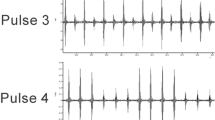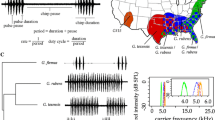Abstract
The Hawaiian cricket genus Laupala (Gryllidae: Trigonidiinae) has undergone rapid and extensive speciation, with divergence in male song and female acoustic preference playing a role in maintaining species boundaries. Recent study of interspecific differences in the diel rhythmicity of singing and mating, suggests that temporal variation in behavior may reduce gene flow between species. In addition, Laupala perform an elaborate and protracted courtship, providing potential for further temporal variation. However, whether these behavioral differences have a genetic basis or result from environmental variation is unknown. We observed courtship and mating in a common garden study of the sympatric species, Laupala cerasina and Laupala paranigra. We document interspecific differences in the onset and duration of courtship, spermatophore production rate, and diel mating rhythmicity. Our study demonstrates a genetic contribution to interspecific behavioral differences, and suggests an evolutionary pathway to the origins of novel timing phenotypes.


Similar content being viewed by others
References
Alexander RD, Bigelow RS (1960) Allochronic speciation in field crickets, and a new species, Acheta veletis. Evolution 14:334–346
Baldwin MW, Winkler H, Organ CL, Helm B (2010) Wing pointedness associated with migratory distance in common-garden and comparative studies of stonechats Saxicola torquata. J Evol Biol 23:1050–1063
Bennet-Clark HC, Ewing AW (1969) Pulse interval as a critical parameter in the courtship song of Drosophila melanogaster. Anim Behav 17:755–759
Boake CRB, Arnold SJ, Breden F, Meffert LM, Ritchie MG, Taylor BJ, Wolf JB, Moore AJ (2002) Genetic tools for studying adaptation and the evolution of behavior. Am Nat 160:S143–S159
Brophy D, Danilowicz BS, King PA (2006) Spawning season fidelity in sympatric populations of Atlantic herring (Clupea harengus). Can J Fish Aquat Sci 63:607–616
Brown WL, Wilson EO (1956) Character displacement. Syst Zool 5:49–64
Campan M, Demai F (1983) The sexual-behavior of Nemobius sylvestris (Orthoptera, Gryllidae). 1. Male and female behavioral repertory. Biol Behav 8:185–204
Caveney S, Scholtz CH, McIntyre P (1995) Patterns of daily flight activity in onitine dung beetles (Scarabaeinae, Onitini). Oecologia 103:444–452
Collins PA (2005) A coexistence mechanism for two freshwater prawns in the Parana River floodplain, Argentina. J Crust Biol 25:219–225
Cooley JR, Simon C, Marshall DC, Slon K, Ehrhardt C (2001) Allochronic speciation, secondary contact, and reproductive character displacement in periodical cicadas (Hemiptera: Magicicada spp.): genetic, morphological, and behavioural evidence. Mol Ecol 10:661–671
Danley PD, deCarvalho TN, Fergus DJ, Shaw KL (2007) Reproductive asynchrony and the divergence of Hawaiian crickets. Ethology 113:1125–1132
Dayan T, Simberloff D (2005) Ecological and community-wide character displacement: the next generation. Ecol Lett 8:875–894
deCarvalho TN, Shaw KL (2005) Nuptial feeding of spermless spermatophores in the Hawaiian swordtail cricket, Laupala pacifica (Gryllidae: Triginodiinae). Naturwissenschaften 92:483–487
deCarvalho TN, Shaw KL (2010a) Divergence of courtship and mating behaviors among endemic Hawaiian swordtail crickets. Behaviour 147:479–504
deCarvalho TN, Shaw KL (2010b) Elaborate courtship enhances sperm transfer in the Hawaiian swordtail cricket, Laupala cerasina. Anim Behav 79:819–826
Dingle H (1991) Evolutionary genetics of animal migration. Am Zool 31:253–264
Feder JL, Filchak KE (1999) It’s about time: the evidence for host plant-mediated selection in the apple maggot fly, Rhagoletis pomonella, and its implications for fitness trade-offs in phytophagous insects. Entomol Exp Appl 91:211–225
French BW, Cade WH (1987) The timing of calling, movement, and mating in the field crickets Gryllus veletis, Gryllus pennsylvanicus, and Gryllus integer. Behav Ecol Sociobiol 21:157–162
Guldemond JA, Tigges WT, Devrijer PWF (1994) Circadian rhythm of sex pheromone production and male activity of coexisting sibling species of Cryptomyzus aphids (Homoptera, Aphididae). Eur J Entomol 91:85–89
Hedwig B (2000) Control of cricket stridulation by a command neuron: efficacy depends on the behavioral state. J Neurophysiol 83:712–722
Huber F, Moore TE, Loher W (1989) Cricket behavior and neurobiology. Comstock Publishing Associates, Ithaca
Kyriacou CP, Hall JC (1980) Circadian rhythm mutations in Drosophila melanogaster affect short-term fluctuations in the males’ courtship song. Proc Natl Acad Sci USA 77:6729–6733
Kyriacou CP, Hall JC (1982) The function of courtship song rhythms in Drosophila. Anim Behav 30:794–801
Kyriacou CP, Hall JC (1986) Interspecific genetic control of courtship song production and reception in Drosophila. Science 232:494–497
Lloyd M, Dybas HS (1966) Periodical cicada problem. II. Evolution. Evolution 20:466–505
Loher W (1972) Circadian control of stridulation in the cricket Teleogryllus commodus Walker. J Comp Physiol 79:173–190
Loher W (1974) Circadian control of spermatophore formation in the cricket Teleogryllus commodus Walker. J Insect Physiol 20:1155–1172
Lutterschmidt DI, Mason RT (2008) Geographic variation in timekeeping systems among three populations of garter snakes (Thamnophis sirtalis) in a common garden. Physiol Biochem Zool 81:810–825
Manley BFJ (1997) Randomization, bootstrap and Monte Carlo methods in biology, 2nd edn. Chapman and Hall/CRC, New York
McFarlane JE (1968) Diel periodicity in spermatophore formation in house cricket Acheta domesticus (L). Can J Zool 46:695–698
Mendel G (1951) Versuche uber pflanzen-hybriden. J Hered 42:3–47
Mendelson TC, Shaw KL (2002) Genetic and behavioral components of the cryptic species boundary between Laupala cerasina and L. kohalensis (Orthoptera: Gryllidae). Genetica 116:301–310
Mendelson TC, Shaw KL (2005) Sexual behaviour: rapid speciation in an arthropod. Nature 433:375–376
Mendelson TC, Shaw KL (2006) Close-range acoustic signaling and mate choice in Hawaiian crickets (Gryllidae: Laupala). Behav Ecol Sociobiol 59:770–776
Miyatake T (1997) Correlated responses to selection for developmental period in Bactrocera cucurbitae (Diptera: Tephritidae): time of mating and daily activity rhythms. Behav Genet 27:489–498
Miyatake T, Kanmiya K (2004) Male courtship song in circadian rhythm mutants of Bactrocera cucurbitae (Tephritidae: Diptera). J Insect Physiol 50:85–91
Miyatake T, Shimizu T (1999) Genetic correlations between life-history and behavioral traits can cause reproductive isolation. Evolution 53:201–208
Miyatake T, Matsumoto A, Matsuyama T, Ueda HR, Toyosato T, Tanimura T (2002) The period gene and allochronic reproductive isolation in Bactrocera cucurbitae. Proc Natl Acad Sci USA 269:2467–2472
Moore IT, Bonier F, Wingfield JC (2005) Reproductive asynchrony and population divergence between two tropical bird populations. Behav Ecol 16:755–762
Popov AV, Shuvalov VF (1977) Phonotactic behavior of crickets. J Comp Physiol 119:111–126
Richards SA (2002) Temporal partitioning and aggression among foragers: modeling the effects of stochasticity and individual state. Behav Ecol 13:427–438
Ritchie MG, Halsey EJ, Gleason JM (1999) Drosophila song as a species-specific mating signal and the behavioural importance of Kyriacou & Hall cycles in D. melanogaster song. Anim Behav 58:649–657
Robinson GE, Fernald RD, Clayton DF (2008) Genes and social behavior. Science 322:896–900
Rost R, Honegger HW (1987) The timing of premating and mating behavior in a field population of the cricket Gryllus campestris L. Behav Ecol Sociobiol 21:279–289
Sakai T, Ishida N (2001) Circadian rhythms of female mating activity governed by clock genes in Drosophila. Proc Natl Acad Sci USA 98:9221–9225
Santos H, Rousselet J, Magnoux E, Paiva MR, Branco M, Kerdelhue C (2007) Genetic isolation through time: allochronic differentiation of a phenologically atypical population of the pine processionary moth. Proc R Soc Lond B Biol Sci 274:935–941
Schoener TW (1974) Resource partitioning in ecological communities. Science 185:27–39
Shaw KL (1996) Polygenic inheritance of a behavioral phenotype: interspecific genetics of song in the Hawaiian cricket genus Laupala. Evolution 50:256–266
Shaw KL (2000) Interspecific genetics of mate recognition: inheritance of female acoustic preference in Hawaiian crickets. Evolution 54:1303–1312
Shaw KL, Herlihy DP (2000) Acoustic preference functions and song variability in the Hawaiian cricket Laupala cerasina. Proc R Soc Lond B Biol Sci 267:577–584
Shaw KL, Khine AH (2004) Courtship behavior in the Hawaiian cricket Laupala cerasina: males provide spermless spermatophores as nuptial gifts. Ethology 110:81–95
Shaw KL, Lugo E (2001) Mating asymmetry and the direction of evolution in the Hawaiian cricket genus Laupala. Mol Ecol 10:751–759
Shine R, Phillips B, Waye H, Lemaster M, Mason RT (2004) Species-isolating mechanisms in a mating system with male mate choice (garter snakes, Thamnophis spp.). Can J Zool 82:1091–1098
Simmons LW (2004) Genotypic variation in calling song and female preferences of the field cricket Teleogryllus oceanicus. Anim Behav 68:313–322
Simon C, Tang JM, Dalwadi S, Staley G, Deniega J, Unnasch TR (2000) Genetic evidence for assortative mating between 13-year cicadas and sympatric “17-year cicadas with 13-year life cycles” provides support for allochronic speciation. Evolution 54:1326–1336
Sokolove PG (1975) Locomotory and stridulatory circadian rhythms in the cricket, Teleogryllus commodus. J Insect Physiol 21:537–558
Stone G, Willmer P, Nee S (1996) Daily partitioning of pollinators in an African Acacia community. Proc R Soc Lond B Biol Sci 263:1389–1393
Tauber CA, Tauber MJ (1977) A genetic model for sympatric speciation through habitat diversification and seasonal isolation. Nature 268:702–705
Tauber E, Roe H, Costa R, Hennessy JM, Kyriacou CP (2003) Temporal mating isolation driven by a behavioral gene in Drosophila. Curr Biol 13:140–145
Toro JE, Thompson RJ, Innes DJ (2002) Reproductive isolation and reproductive output in two sympatric mussel species (Mytilus edulis, M. trossulus) and their hybrids from Newfoundland. Mar Biol 141:897–909
Wolf JB, Wade MJ (2009) What are maternal effects (and what are they not)? Philos Trans R Soc Lond B Biol Sci 364:1107–1115
Wong A, Boutis P, Hekimi S (1995) Mutations in the Clk-1 Gene of Caenorhabditis elegans affect developmental and behavioral timing. Genetics 139:1247–1259
Zuk M, Simmons LW (1997) Reproductive strategies of the crickets (Orthoptera: Gryllidae). In: Choe JC, Crespi BJ (eds) The evolution of mating systems in insects and arachnids. Cambridge University Press, Cambridge
Acknowledgments
DJF was supported by an NIH training grant (No. 5T32GM007469 to the Cornell graduate field of Neurobiology and Behavior). We would like to thank Chris Wiley, Holly Menninger, Brian Coyle, Chris Ellison, and Elizabeth Turnell for valuable discussion and feedback. We thank the BEES graduate program at the University of Maryland for support in the early phases of this project.
Author information
Authors and Affiliations
Corresponding author
Additional information
Edited by Yong-Kyu Kim.
Rights and permissions
About this article
Cite this article
Fergus, D.J., deCarvalho, T.N. & Shaw, K.L. Genetically Regulated Temporal Variation of Novel Courtship Elements in the Hawaiian Cricket Genus Laupala . Behav Genet 41, 607–614 (2011). https://doi.org/10.1007/s10519-010-9397-2
Received:
Accepted:
Published:
Issue Date:
DOI: https://doi.org/10.1007/s10519-010-9397-2




